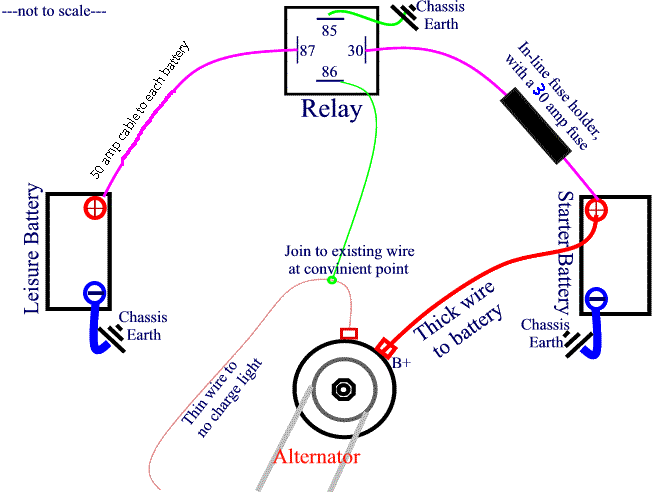Page 1 of 2
VOLTAGE SENSING SPLIT CHARGE UNIT
Posted: 14 Jun 2011, 08:43
by foggygolf
Hi All
Has anybody used or come across one of these
http://cgi.ebay.co.uk/VOLTAGE-SENSING-S ... 842wt_1141" onclick="window.open(this.href);return false; if so any feedback?
Cheers
Rich
Re: VOLTAGE SENSING SPLIT CHARGE UNIT
Posted: 14 Jun 2011, 10:53
by Oldiebut goodie
Under-rated , they are only 30Amp. Can be used to switch a larger relay (80-100A) Or you could just use a 100A self switching one.
Re: VOLTAGE SENSING SPLIT CHARGE UNIT
Posted: 14 Jun 2011, 13:26
by California Dreamin
http://cgi.ebay.co.uk/Split-Charge-Sens ... 35b23f84d7" onclick="window.open(this.href);return false;
Looks good..
Martin
Re: VOLTAGE SENSING SPLIT CHARGE UNIT
Posted: 14 Jun 2011, 13:44
by foggygolf
I'm just confused now!!!!
I keep putting off ordering things as not 100% on what i need (i have read the wiki).
I need a leisure battery somebody recommended this
http://www.alpha-batteries.co.uk/buy-on ... d_102.html" onclick="window.open(this.href);return false; so was about to order then somebody said check your alternator will be upto it!!
And as for relay confused as to what ampage i need and what the difference is!
If anybody has time on their hands and wants to write me a list then feel free

Re: VOLTAGE SENSING SPLIT CHARGE UNIT
Posted: 14 Jun 2011, 14:10
by Oldiebut goodie
Absolutely useless - it's 24v - it only starts charging at 26.6v !!!1
Re: VOLTAGE SENSING SPLIT CHARGE UNIT
Posted: 14 Jun 2011, 17:02
by kevtherev
Do you have to use a Voltage sensing type?
you could simplify things with just a £5 40A split charge relay..
Re: VOLTAGE SENSING SPLIT CHARGE UNIT
Posted: 14 Jun 2011, 19:59
by foggygolf
Hi kev
I just want the easiest option that will work with my current battery,alternator and this my proposed leisure battery
http://www.alpha-batteries.co.uk/buy-on ... d_102.html" onclick="window.open(this.href);return false;
Cheers
Rich
Re: VOLTAGE SENSING SPLIT CHARGE UNIT
Posted: 14 Jun 2011, 21:58
by California Dreamin
I've corrected my link.....stupid me read the spec then posted the wrong link, apologies for any confusion this may have caused....this is now the correct link.
http://cgi.ebay.co.uk/Split-Charge-Sens ... 35b23f84d7" onclick="window.open(this.href);return false;
To try and clarify.....voltage sensing relays offer easy fitment over traditional split charge setups because there is no 'trigger' switch wire going back to the alternator so the wiring is much simpler.
30 amp relays are considered 'just' good enough to cope with a single (85-100amp) leisure battery but as this circuit will often blow a 25 amp fuse from flat you can see a 30 amp relay is on the limit.
This is why most users on here will advise a bigger relay and heavier wiring. Unfortunately there seems to be a bit of a jump from 30 thats why I linked the next heaviest (60amp) 40amp and above recommended. There really isn't any issue in going 100/120amp on the relay but it's just unnecessary on a single leisure battery setup.
I hope this makes things a little clearer.
Martin
Re: VOLTAGE SENSING SPLIT CHARGE UNIT
Posted: 15 Jun 2011, 08:44
by Hacksawbob
http://cgi.ebay.co.uk/12V-SPLIT-CHARGE- ... 0539536358 This one adds an LED to show its working, (I had one in my shed, gone to live in someone else shed now

! )
Re: VOLTAGE SENSING SPLIT CHARGE UNIT
Posted: 15 Jun 2011, 21:47
by foggygolf
Sorry to post again but any thoughts on this one? I want the best for my money!
http://cgi.ebay.co.uk/ws/eBayISAPI.dll? ... 1801wt_989" onclick="window.open(this.href);return false;
Re: VOLTAGE SENSING SPLIT CHARGE UNIT
Posted: 16 Jun 2011, 13:26
by California Dreamin
Absolutely fine but as this is a non voltage sensing relay it will need a trigger (to switch the relay when the alternator is charging)
This means routing an extra wire back from the alternators 'exciter' wire to the relay (not as difficult as it sound)
This is how most split charge relays worked up until 'intelligent' relays were introduced onto the market.
I suggest using at least 45amp cable on the live switched side of the relay, a 30amp fuse/holder near the starter battery to be going on with (poss 40 amps if the 30 blows regularly). The switching and earth side of the relay need only be fairly low amperage cable (17.5amp).
Martin
Re: VOLTAGE SENSING SPLIT CHARGE UNIT
Posted: 17 Jun 2011, 21:32
by AngeloEvs
The one that California Dreamin linked is a good choice, having said that I have a 30A Smart Relay fitted with a 30A in line fuse charging a 85A/hr leisure battery with absolutely no issues over the last two years!
Re: VOLTAGE SENSING SPLIT CHARGE UNIT
Posted: 20 Jun 2011, 11:41
by California Dreamin
Now we know you have a diesel things change a little bit....The starter battery is in the engine bay so linking the two batteries becomes slightly more hassel given the fact that if you use your battery boxes under the front seats the wiring would have to be pretty long.
It might be just as easy to install the Leisure under the R&R bed, making sure that it is secure and has a vent pipe going out to the open. This would be a much shorter distance for the battery 'link' cabling. I would also suggest the relay is also mounted in this nice dry place for reliability.
given you are already wiring back to the engine bay you might as well go with the cheap 'non intelligent' type of relay and pick up the trigger supply from the alternator.
See attached drawing..

Martin
Re: VOLTAGE SENSING SPLIT CHARGE UNIT
Posted: 20 Jun 2011, 19:44
by foggygolf
Great advice Martin much appreciated - going to order all relevant wiring etc and hopefully make a start later in the week. I'll post some pics!
Cheers
Rich
Re: VOLTAGE SENSING SPLIT CHARGE UNIT
Posted: 27 Jun 2011, 21:18
by 1_eyed_jim
foggygolf wrote:Great advice Martin much appreciated - going to order all relevant wiring etc and hopefully make a start later in the week. I'll post some pics!
Cheers
Rich
Got a relay here if your after one?
ta
